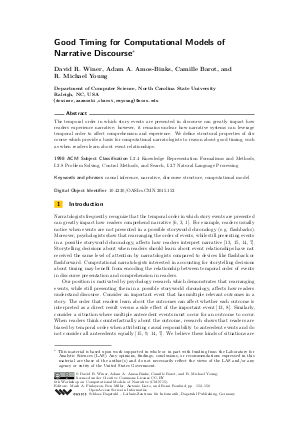Good Timing for Computational Models of Narrative Discourse
Authors David R. Winer, Adam A. Amos-Binks, Camille Barot, R. Michael Young
-
Part of:
Volume:
6th Workshop on Computational Models of Narrative (CMN 2015)
Part of: Series: Open Access Series in Informatics (OASIcs) - License:
 Creative Commons Attribution 3.0 Unported license
Creative Commons Attribution 3.0 Unported license
- Publication Date: 2015-08-14
File

PDF
OASIcs.CMN.2015.152.pdf
- Filesize: 355 kB
- 5 pages
Document Identifiers
Subject Classification
Keywords
- causal inference
- narrative
- discourse structure
- computational model
Metrics
- Access Statistics
-
Total Accesses (updated on a weekly basis)
0PDF Downloads0Metadata Views
Abstract
The temporal order in which story events are presented in discourse can greatly impact how readers experience narrative; however, it remains unclear how narrative systems can leverage temporal order to affect comprehension and experience. We define structural properties of discourse which provide a basis for computational narratologists to reason about good timing, such as when readers learn about event relationships.
Cite As Get BibTex
David R. Winer, Adam A. Amos-Binks, Camille Barot, and R. Michael Young. Good Timing for Computational Models of Narrative Discourse. In 6th Workshop on Computational Models of Narrative (CMN 2015). Open Access Series in Informatics (OASIcs), Volume 45, pp. 152-156, Schloss Dagstuhl – Leibniz-Zentrum für Informatik (2015)
https://doi.org/10.4230/OASIcs.CMN.2015.152
BibTex
@InProceedings{winer_et_al:OASIcs.CMN.2015.152,
author = {Winer, David R. and Amos-Binks, Adam A. and Barot, Camille and Young, R. Michael},
title = {{Good Timing for Computational Models of Narrative Discourse}},
booktitle = {6th Workshop on Computational Models of Narrative (CMN 2015)},
pages = {152--156},
series = {Open Access Series in Informatics (OASIcs)},
ISBN = {978-3-939897-93-4},
ISSN = {2190-6807},
year = {2015},
volume = {45},
editor = {Finlayson, Mark A. and Miller, Ben and Lieto, Antonio and Ronfard, Remi},
publisher = {Schloss Dagstuhl -- Leibniz-Zentrum f{\"u}r Informatik},
address = {Dagstuhl, Germany},
URL = {https://drops.dagstuhl.de/entities/document/10.4230/OASIcs.CMN.2015.152},
URN = {urn:nbn:de:0030-drops-52897},
doi = {10.4230/OASIcs.CMN.2015.152},
annote = {Keywords: causal inference, narrative, discourse structure, computational model}
}
Author Details
References
-
Edward Branigan. Narrative comprehension and film. Routledge, 1992.

-
Rogelio E. Cardona-Rivera, Bradley A. Cassell, Stephen G. Ware, and R. Michael Young. Indexter: A computational model of the event-indexing situation model for characterizing narratives. In The Workshop on Computational Models of Narrative at the Language Resources and Evaluation Conference, pages 32-41, 2012.

-
Seymour Benjamin Chatman. Story and discourse: Narrative structure in fiction and film. Cornell University Press, 1980.

-
Yun Gyung Cheong and R. Michael Young. Suspenser: A Story Generation System for Suspense. IEEE Transactions on Computational Intelligence and AI in Games, 11(4):1-1, 2014.

-
David B. Christian and R. Michael Young. Comparing cognitive and computational models of narrative structure. In Proceedings of the 19th AAAI Conference on Artificial Intelligence, pages 385-390, 2004.

-
Gérard Genette and Jane E. Lewin. Narrative discourse: An essay in method. Cornell University Press, 1983.

-
David A. Lagnado, Tobias Gerstenberg, and Ro'i Zultan. Causal responsibility and counterfactuals. Cognitive science, 37(6):1036-73, 2013.

-
John Mikhail. Universal moral grammar: Theory, evidence and the future. Trends in cognitive sciences, 11(4):143-152, 2007.

-
Jerome L. Myers, Makiko Shinjo, and Susan A. Duffy. Degree of causal relatedness and memory. Journal of Memory and Language, 26(4):453-465, 1987.

-
James. Niehaus and R. Michael Young. Cognitive models of discourse comprehension for narrative generation. Literary and Linguistic Computing, 29(4):561-582, 2014.

-
Brian O'Neill and Mark Riedl. Dramatis: A computational model of suspense. In Proceedings of the 28th AAAI Conference on Artificial Intelligence, pages 944-950, 2014.

-
Gabriel A. Radvansky, Andrea K. Tamplin, Joseph Armendarez, and Alexis N. Thompson. Different Kinds of Causality in Event Cognition. Discourse Processes, 51(7):601-618, 2014.

-
Stephen J. Read, Peter R. Druian, and Lynn Carol Miller. The role of causal sequence in the meaning of actions. British journal of social psychology, 28(4):341-351, 1989.

-
Susana Segura, Pablo Fernandez-Berrocal, and Ruth M. J. Byrne. Temporal and causal order effects in thinking about what might have been. The Quarterly journal of experimental psychology. A, Human experimental psychology, 55(4):1295-305, 2002.

-
Barbara A Spellman. Crediting causality. Journal of Experimental Psychology: General, 126(4):323-348, 1997.

-
Tom Trabasso and Linda L. Sperry. Causal relatedness and importance of story events. Journal of Memory and language, 24(5):595-611, 1985.

-
R. Michael Young. Using grice’s maxim of quantity to select the content of plan descriptions. Artificial Intelligence, 115(2):215-256, 1999.

-
Rolf A. Zwaan and Gabriel A. Radvansky. Situation models in language comprehension and memory. Psychological bulletin, 123(2):162, 1998.

